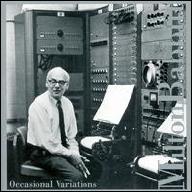Milton Babbitt
from Philadelphia, PA
May 10, 1916 - January 29, 2011 (age 94)
Biography
Milton Babbitt studied math at the University of Pennsylvania for a short time before transferring to New York University to study music. He attended graduate school in music at Princeton University, where he later became a faculty member. During WWII he worked as a mathematical researcher and at this time developed his ideas concerning Schoenberg's twelve-tone serial compositional method. Babbitt was a pioneer in introducing terms from other areas into musical discourse. He explored the use of non-pitch components and advocated the reinterpretation of the elements of traditional Western music. Babbitt was the first composer to work seriously with an electronic synthesizer. His Composition for Synthesizer, written in 1961, was his first totally synthesized work. He was attracted to the instrument because it enabled him to control all aspects of the composition, especially those of timing and the rate of change in timbre, intensity, and texture. His work is expressive and lyrical, despite its highly ordered structure. ~ Lynn Vought, Rovi
Top Tracks
Albums
Videos
Close



















